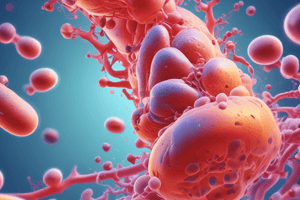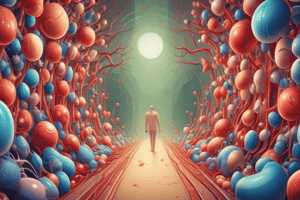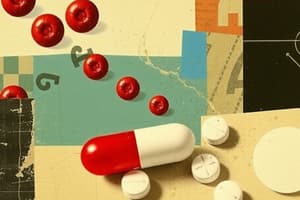Podcast
Questions and Answers
Which of the following components play a role in platelet plug formation?
Which of the following components play a role in platelet plug formation?
- Antithrombin III
- Protein C
- Thrombin
- PDE (correct)
What is the role of arachidonic acid in platelet activation?
What is the role of arachidonic acid in platelet activation?
- Inhibits platelet aggregation
- Precursor for TxA2 synthesis (correct)
- Decreases intracellular calcium concentration
- Stabilizes platelet membranes
Which of the following antiplatelet drugs primarily acts by inhibiting the P2Y12 receptor?
Which of the following antiplatelet drugs primarily acts by inhibiting the P2Y12 receptor?
- Aspirin
- Glycoprotein IIb/IIIa inhibitors
- Clopidogrel (correct)
- Dabigatran
What is the inhibition mechanism of action for aspirin in antiplatelet therapy?
What is the inhibition mechanism of action for aspirin in antiplatelet therapy?
Which of the following best describes the function of glycoprotein IIb/IIIa on platelets?
Which of the following best describes the function of glycoprotein IIb/IIIa on platelets?
What is a significant adverse event associated with clopidogrel therapy?
What is a significant adverse event associated with clopidogrel therapy?
Which metabolic pathway is clinically significant for the activation of clopidogrel?
Which metabolic pathway is clinically significant for the activation of clopidogrel?
The structure of the active metabolite of clopidogrel is primarily derived from which substance?
The structure of the active metabolite of clopidogrel is primarily derived from which substance?
Which of the following factors does NOT directly influence platelet activation?
Which of the following factors does NOT directly influence platelet activation?
Which antiplatelet agent works primarily by inhibiting the glycoprotein IIb/IIIa receptor?
Which antiplatelet agent works primarily by inhibiting the glycoprotein IIb/IIIa receptor?
What is the primary abnormality associated with hemostasis?
What is the primary abnormality associated with hemostasis?
Which type of thrombus is primarily associated with myocardial infarction?
Which type of thrombus is primarily associated with myocardial infarction?
What are the three main steps in the formation of a hemostatic plug?
What are the three main steps in the formation of a hemostatic plug?
Which two molecular interactions are essential for platelet adhesion?
Which two molecular interactions are essential for platelet adhesion?
What role does von Willebrand Factor (vWF) play in hemostasis?
What role does von Willebrand Factor (vWF) play in hemostasis?
What is a characteristic feature of red thrombus?
What is a characteristic feature of red thrombus?
Which condition is primarily linked with cardioembolic strokes?
Which condition is primarily linked with cardioembolic strokes?
What is the effect of activated platelets on von Willebrand Factor?
What is the effect of activated platelets on von Willebrand Factor?
Which thrombosis is associated with the risk of pulmonary embolism?
Which thrombosis is associated with the risk of pulmonary embolism?
Which interaction is particularly important for platelet Glycoprotein VI?
Which interaction is particularly important for platelet Glycoprotein VI?
What is the mechanism by which aspirin reduces platelet activation?
What is the mechanism by which aspirin reduces platelet activation?
What is the primary role of phospholipase A2 (PLA2) in platelet activation?
What is the primary role of phospholipase A2 (PLA2) in platelet activation?
Which antiplatelet drug is classified as an irreversible P2Y12 blocker?
Which antiplatelet drug is classified as an irreversible P2Y12 blocker?
Which of the following best describes the action of vorapaxar?
Which of the following best describes the action of vorapaxar?
Which of the following antiplatelet agents irreversibly inhibits the ADP receptor?
Which of the following antiplatelet agents irreversibly inhibits the ADP receptor?
Which drugs act by blocking the final common pathway of platelet aggregation?
Which drugs act by blocking the final common pathway of platelet aggregation?
What is the mechanism of action of aspirin in the context of antiplatelet therapy?
What is the mechanism of action of aspirin in the context of antiplatelet therapy?
What unique property differentiates ticagrelor from other P2Y12 blockers?
What unique property differentiates ticagrelor from other P2Y12 blockers?
What is a common adverse effect of P2Y12 receptor inhibitors?
What is a common adverse effect of P2Y12 receptor inhibitors?
Which dosage form is common for GPIIb/IIIa inhibitors like Abciximab?
Which dosage form is common for GPIIb/IIIa inhibitors like Abciximab?
Which receptor does ticlopidine specifically target to exert its antiplatelet effects?
Which receptor does ticlopidine specifically target to exert its antiplatelet effects?
What is the result of reduced thromboxane A2 release in the context of platelet activity?
What is the result of reduced thromboxane A2 release in the context of platelet activity?
Cilostazol primarily functions by inhibiting which enzyme?
Cilostazol primarily functions by inhibiting which enzyme?
Which statement about thromboxane A2 is true?
Which statement about thromboxane A2 is true?
Which drug is a reversible inhibitor of P2Y12?
Which drug is a reversible inhibitor of P2Y12?
What role does eptifibatide play in platelet aggregation?
What role does eptifibatide play in platelet aggregation?
What happens during platelet degranulation?
What happens during platelet degranulation?
Which of the following correctly describes the route of action for antiplatelet drugs like abciximab?
Which of the following correctly describes the route of action for antiplatelet drugs like abciximab?
Which medication is an active drug that mimics adenosine?
Which medication is an active drug that mimics adenosine?
What is the primary indication for using GPIIb/IIIa inhibitors during percutaneous coronary intervention (PCI)?
What is the primary indication for using GPIIb/IIIa inhibitors during percutaneous coronary intervention (PCI)?
Flashcards
Platelet plug formation
Platelet plug formation
A process where platelets clump together to stop bleeding.
cAMP role in platelets
cAMP role in platelets
cAMP inhibits platelet activation and aggregation
Ca2+ role in platelets
Ca2+ role in platelets
Ca2+ promotes platelet activation and aggregation.
vWF role in platelets
vWF role in platelets
Signup and view all the flashcards
Antiplatelet Drugs
Antiplatelet Drugs
Signup and view all the flashcards
Clopidogrel mechanism
Clopidogrel mechanism
Signup and view all the flashcards
Arachidonic Acid Pathway
Arachidonic Acid Pathway
Signup and view all the flashcards
TXA2
TXA2
Signup and view all the flashcards
Platelet Glycoprotein Ib
Platelet Glycoprotein Ib
Signup and view all the flashcards
Platelet Glycoprotein IIb/IIIa
Platelet Glycoprotein IIb/IIIa
Signup and view all the flashcards
Aspirin's antiplatelet mechanism
Aspirin's antiplatelet mechanism
Signup and view all the flashcards
Ticlopidine's action
Ticlopidine's action
Signup and view all the flashcards
Clopidogrel's function
Clopidogrel's function
Signup and view all the flashcards
Prasugrel's mechanism
Prasugrel's mechanism
Signup and view all the flashcards
Cangrelor's role
Cangrelor's role
Signup and view all the flashcards
Ticagrelor's action
Ticagrelor's action
Signup and view all the flashcards
Platelet aggregation inhibition (Abciximab, etc.)
Platelet aggregation inhibition (Abciximab, etc.)
Signup and view all the flashcards
Vorapaxar's function
Vorapaxar's function
Signup and view all the flashcards
Antiplatelet drugs' target
Antiplatelet drugs' target
Signup and view all the flashcards
Platelet activation pathway
Platelet activation pathway
Signup and view all the flashcards
Hemostasis
Hemostasis
Signup and view all the flashcards
Thrombosis
Thrombosis
Signup and view all the flashcards
White thrombus
White thrombus
Signup and view all the flashcards
Myocardial Infarction (MI)
Myocardial Infarction (MI)
Signup and view all the flashcards
Platelet Activation
Platelet Activation
Signup and view all the flashcards
Granule Release
Granule Release
Signup and view all the flashcards
Transient Ischemic Attack (TIA)
Transient Ischemic Attack (TIA)
Signup and view all the flashcards
Red thrombus
Red thrombus
Signup and view all the flashcards
Aggregation & Consolidation
Aggregation & Consolidation
Signup and view all the flashcards
Cardioembolic stroke
Cardioembolic stroke
Signup and view all the flashcards
COX-1 Inhibitors (e.g., Aspirin)
COX-1 Inhibitors (e.g., Aspirin)
Signup and view all the flashcards
Deep Vein Thrombosis (DVT)
Deep Vein Thrombosis (DVT)
Signup and view all the flashcards
P2Y12 Inhibitors (e.g., Clopidogrel)
P2Y12 Inhibitors (e.g., Clopidogrel)
Signup and view all the flashcards
GPIIb/IIIa Inhibitors (e.g., Abciximab)
GPIIb/IIIa Inhibitors (e.g., Abciximab)
Signup and view all the flashcards
Platelet Adhesion
Platelet Adhesion
Signup and view all the flashcards
von Willebrand Factor (vWF)
von Willebrand Factor (vWF)
Signup and view all the flashcards
Phosphodiesterase Inhibitors (e.g., Cilostazol)
Phosphodiesterase Inhibitors (e.g., Cilostazol)
Signup and view all the flashcards
Hemostatic Plug Formation
Hemostatic Plug Formation
Signup and view all the flashcards
Platelet Aggregation Inhibitors
Platelet Aggregation Inhibitors
Signup and view all the flashcards
Thromboxane A2 (TxA2)
Thromboxane A2 (TxA2)
Signup and view all the flashcards
Study Notes
Lecture #28: Antiplatelet Pharmacology
- Presenter: Brian Skinner, PharmD, BCPS
- Affiliation: Associate Professor of Internal Medicine, Marian University - College of Osteopathic Medicine
- Course: BMS 551 Med Phys Pharm
- Year: Fall 2024
Objectives
- Describe platelet plug formation, identifying the roles of: cAMP, Ca²⁺, vWF, PLA₂, arachidonic acid, TxA₂, ADP, PKC, PKA, PDE
- Identify the roles of platelet glycoproteins Ib, IIb/IIIa, and VI in platelet plug formation
- Identify the mechanism of action, dosage forms, adverse events, indications, and contraindications of highlighted antiplatelet drugs
- Describe the clinically significant metabolic pathway for clopidogrel
- Identify the structure of the active metabolite of clopidogrel
- Diagram arachidonic acid pathway relating to PGE₂, TxA₂, and leukotriene synthesis
- Recommend appropriate pharmacotherapeutic strategies for simplified patient cases
Drug Overview
- COX Inhibitors: Aspirin
- P2Y₁₂ Receptors Blockers: Clopidogrel, Prasugrel, Ticlopidine, Ticagrelor, Cangrelor
- GP IIb/IIIa Inhibitors: Abciximab, Eptifibatide, Tirofiban
- Phosphodiesterase Inhibitors: Cilostazol, Dipyridamole
Hemostasis and Thrombosis
- Hemostasis: The process of stopping blood flow
- Thrombosis: The most common abnormality of hemostasis
- Types of clots:
- Platelet-rich (white thrombus): Myocardial Infarction (MI), Transient Ischemic Attacks (TIAs)
- Fibrin-rich (red thrombus): Peripheral Arterial Clots, Cardioembolic strokes, Deep Vein Thrombosis (DVT), Pulmonary Embolism (PE)
Formation of a Hemostatic Plug
- Three main steps: Adhesion, Granule Release, Aggregation & Consolidation
Platelet Adhesion
- vWF secreted by activated platelets and exposed collagen
- vWF binds to Glycoprotein Ib on activated platelets
- Platelet Glycoprotein VI (GPVI) expressed on platelet surface interacts with collagen (GPVI:collagen interaction)
Granule Release
- Numerous chemical mediators released in response to platelet activation
- ADP, epinephrine, collagen activate phospholipase A₂ (PLA₂)
- Arachidonic acid converted into thromboxane A₂ by cyclooxygenase-1 (COX-1)
- ADP, Ca²⁺, ATP, serotonin, vWF, and platelet factor 4 released during degranulation
Aggregation & Consolidation
- Increased cytosolic calcium and activation of thromboxane A₂ and the GPIIb/IIIa receptors lead to further platelet activation
- Thrombin, thromboxane A₂, ADP, and other mediators increase Ca²⁺ levels.
COX-1 Inhibitors (Aspirin)
- Mechanism: Irreversible inhibition of COX-1 enzyme via acetylation
- Indications: Secondary prophylaxis following MI or stroke, prevention of thrombotic events
- Adverse Effects: GI bleeding & ulcer formation, increased risk of asthma exacerbations
P2Y₁₂ ADP Receptor Inhibitors (Clopidogrel, Ticagrelor)
- Mechanism: Clopidogrel is a prodrug activated by CYP2C19, irreversibly binding to and inactivating the ADP receptor; Ticagrelor reversibly binds to the ADP receptor mimicking adenosine
- Indications: Secondary prophylaxis following MI or stroke, prevention of thrombotic events during PCI
- Adverse Effects: Bleeding
GPIIb/IIIa Inhibitors (Abciximab, Eptifibatide, Tirofiban)
- Mechanism: Monoclonal antibodies that reversibly bind to and inactivate GPIIb/IIIa preventing fibrinogen interaction and platelet aggregation
- Indications: Prevention of thrombotic events during PCI as an alternative to P2Y12 inhibitors
- Adverse Effects: Bleeding
Phosphodiesterase Inhibitors (Cilostazol)
- Mechanism: Inhibition of phosphodiesterase-3 (PDE3) leading to increased cAMP catabolism
- Indications: Intermittent claudication
- Adverse Effects: Bleeding, headache (cerebral vasodilation), contraindicated for heart failure
Studying That Suits You
Use AI to generate personalized quizzes and flashcards to suit your learning preferences.
Related Documents
Description
This quiz focuses on the key concepts of antiplatelet pharmacology covered in Lecture #28 of the BMS 551 course. Students will explore platelet plug formation, the mechanisms of various antiplatelet drugs, and clinical implications related to their use. Prepare to navigate through essential pathways and recommend pharmacotherapeutic strategies based on case studies.




